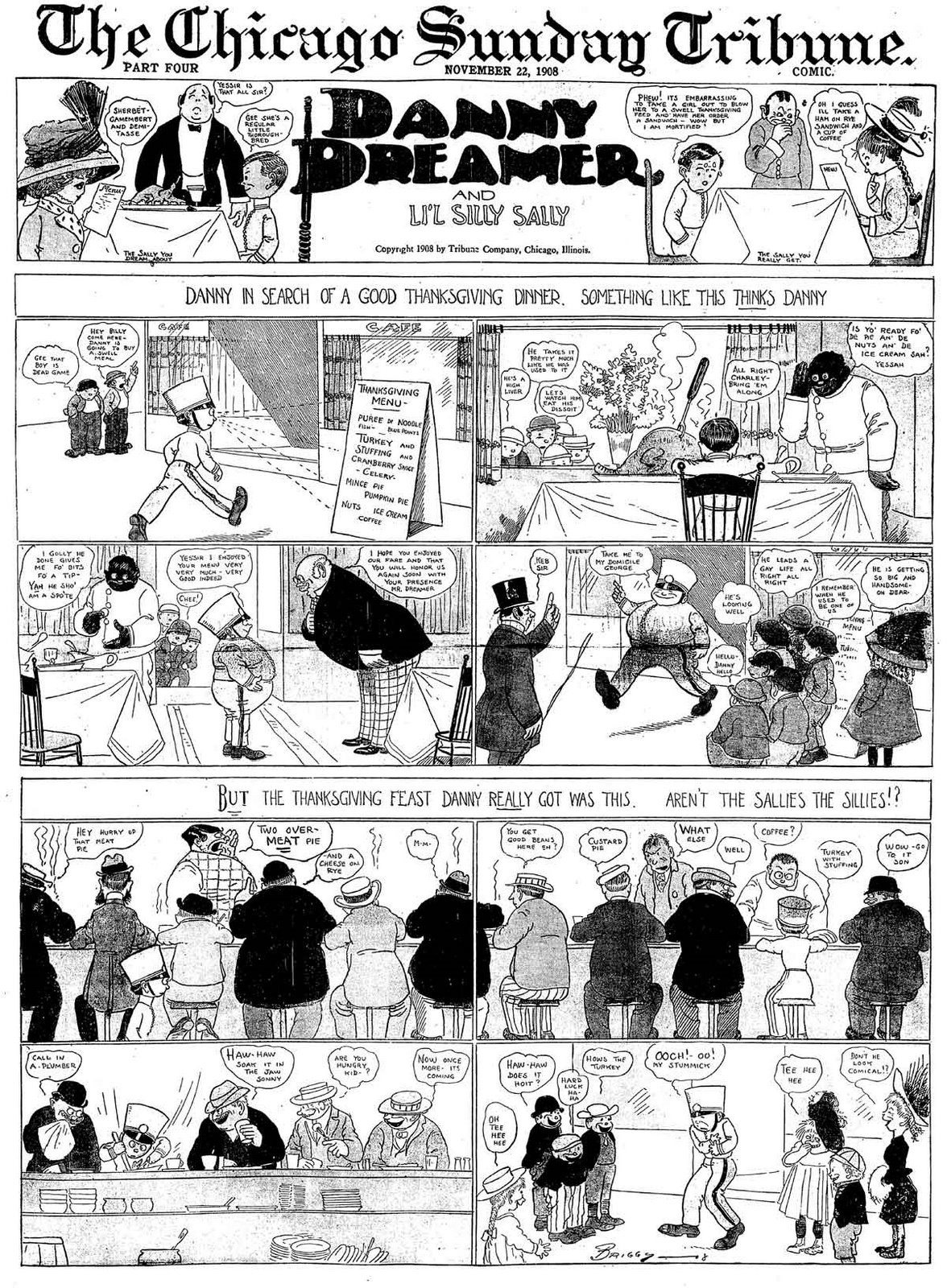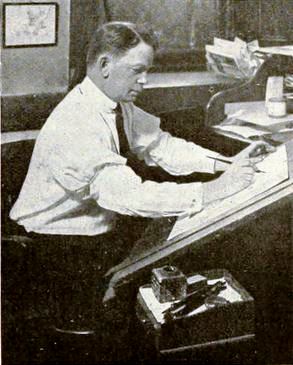Clare Briggs on:
[Wikipedia]
[Google]
[Amazon]
Clare A. Briggs (August 5, 1875 – January 3, 1930) was an early American comic strip artist who rose to fame in 1904 with his strip '' A. Piker Clerk''. Briggs was best known for his later comic strips ''When a Feller Needs a Friend'', ''Ain't It a Grand and Glorious Feeling?'', ''The Days of Real Sport'',"Claire Briggs - Cartoon Genius Dies at 54"
/ref> and ''Mr. and Mrs.''
 While attending the
While attending the
 Briggs was a popular lecturer, earning $100 for a single speech. He accepted a five-week contract for $500 a week to appear on the
Briggs was a popular lecturer, earning $100 for a single speech. He accepted a five-week contract for $500 a week to appear on the
Lambiek Comiclopedia
*
Billy Ireland Cartoon Library & Museum Art Database
{{DEFAULTSORT:Briggs, Clare 1875 births 1930 deaths American comic strip cartoonists American comics artists St. Louis Globe-Democrat people People from Reedsburg, Wisconsin Artists from New Rochelle, New York University of Nebraska–Lincoln alumni
/ref> and ''Mr. and Mrs.''
Early life
Born inReedsburg, Wisconsin
Reedsburg is a city in Sauk County, Wisconsin
Sauk County is a county in Wisconsin. It is named after a large village of the Sauk people. As of the 2020 census, the population was 65,763. Its county seat and largest city is Baraboo. The cou ...
, Briggs lived there until the age of nine. In 1884, his family moved to Dixon, Illinois, where he started his newspaper career at age ten, delivering the local paper to subscribers for 40 cents a week while wearing a red, white and blue cap with the name of the newspaper.
Briggs had three brothers, who grew up to all have creative careers, one as a musician, one as a writer, and the third in advertising. After five years in Dixon, Briggs was 14 when his family relocated to Lincoln, Nebraska
Lincoln is the capital city of the U.S. state of Nebraska and the county seat of Lancaster County. The city covers with a population of 292,657 in 2021. It is the second-most populous city in Nebraska and the 73rd-largest in the United Sta ...
, where he lived until 1896 when he was 21. Life in the Midwest gave Briggs the source material for the small town Americana that he later depicted in his cartoons.
A push from Pershing
 While attending the
While attending the University of Nebraska
A university () is an institution of higher (or tertiary) education and research which awards academic degrees in several academic disciplines. Universities typically offer both undergraduate and postgraduate programs. In the United States, ...
for two years, he studied drawing and stenography. Employment as a stenographer brought him six dollars a week when the work was available. One of his art instructors was an editor with ''Western Penman'', where his first published drawings appeared. His mathematics teacher was Lieutenant John J. Pershing. "If ever a fellow needed a friend, I did in mathematics," said Briggs. "It happened that Lieutenant Pershing was my instructor, and I believe he will testify that it was easier to conquer Germany than to teach me math. One day he ordered me to the blackboard to demonstrate a theorem, and while I was giving the problem a hard but losing battle, he remarked: 'Briggs, sit down, you don't know anything.' Right then and there, I decided to become a newspaper man."
On July 18, 1900, he married Ruth Owen of Lincoln. He began his career as a newspaper sketch artist in St. Louis, Missouri with the '' Globe-Democrat'', which sent him off to cover the Spanish–American War
, partof = the Philippine Revolution, the decolonization of the Americas, and the Cuban War of Independence
, image = Collage infobox for Spanish-American War.jpg
, image_size = 300px
, caption = (cloc ...
as an editorial cartoon
A political cartoon, a form of editorial cartoon, is a cartoon graphic with caricatures of public figures, expressing the artist's opinion. An artist who writes and draws such images is known as an editorial cartoonist. They typically combine a ...
ist. Relocating in New York, his drawings for the '' New York Journal'' prompted William Randolph Hearst
William Randolph Hearst Sr. (; April 29, 1863 – August 14, 1951) was an American businessman, newspaper publisher, and politician known for developing the nation's largest newspaper chain and media company, Hearst Communications. His flamboya ...
to send Briggs to the '' Chicago Herald'' and the ''Chicago's American
The ''Chicago American'' was an afternoon newspaper published in Chicago, under various names until its dissolution in 1974.
History
The paper's first edition came out on July 4, 1900, as '' Hearst's Chicago American''. It became the ''Morning ...
'', where he created '' A. Piker Clerk'', often described as the first daily continuity comic strip. After 17 years in Chicago (living in the community of Riverside, Illinois
Riverside is a suburban village in Cook County, Illinois, United States. A significant portion of the village is in the Riverside Landscape Architecture District, designated a National Historic Landmark in 1970. The population of the village was ...
), Briggs returned to New York to spend the remaining 13 years of his life with the '' New York Tribune''. He lived in to the suburban community of New Rochelle
New Rochelle (; older french: La Nouvelle-Rochelle) is a city in Westchester County, New York, United States, in the southeastern portion of the state. In 2020, the city had a population of 79,726, making it the seventh-largest in the state o ...
, a well-known art colony and home to a majority of the top commercial illustrators of the day.
During the 1920s, the New Rochelle Art Association commissioned its best known artists to create a series of signs on major roadways to mark the borders, including "New Rochelle The Place To Come When a Feller Needs a Friend", which was created by Briggs representing one of his major comics, "When a Feller Needs a Friend".
Clare and Ruth Owen Briggs were together for 29 years and had three children. They divorced in February 1929. Briggs died ten months later, leaving his estate of $90,067 to Ruth Briggs. However, the will was challenged by his second wife, Marie C. Briggs, aka Maggie Touhey.
Vaudeville, films and radio
 Briggs was a popular lecturer, earning $100 for a single speech. He accepted a five-week contract for $500 a week to appear on the
Briggs was a popular lecturer, earning $100 for a single speech. He accepted a five-week contract for $500 a week to appear on the vaudeville
Vaudeville (; ) is a theatrical genre of variety entertainment born in France at the end of the 19th century. A vaudeville was originally a comedy without psychological or moral intentions, based on a comical situation: a dramatic composition ...
circuit in 1914. In 1919, he produced four comedy film shorts for Paramount Pictures.
The ''Mr. and Mrs.'' radio series, based on Briggs' strip, starred Jack Smart and Jane Houston as Jo and Vi. The series was broadcast on CBS from 1929 to 1931.
National catchphrase
A catchphrase (alternatively spelled catch phrase) is a phrase or expression recognized by its repeated utterance. Such phrases often originate in popular culture and in the arts, and typically spread through word of mouth and a variety of mass ...
s caught on from the titles of some of his newspaper cartoon features: ''Ain't It a Grand and Glorious Feeling?'', ''Danny Dreamer'', ''The Days of Real Sport'', ''Movie of a Man'', ''Mr. and Mrs'', ''Real Folks at Home'', ''Someone's Always Taking the Joy Out of Life'', ''There's at Least One in Every Office'' and ''When a Feller Needs a Friend''. ''Mr. and Mrs.'' ran during the last years of his life and continued in syndication by the New York Herald Tribune Syndicate after his death under his name. (The names of Arthur Folwell and Ellison Hoover finally appeared on the strip in 1938; Frank Fogarty illustrated the Sunday strips from 1930 to 1946.) In 1947, the strip was taken over by Kin Platt
Kin Platt (December 8, 1911 – November 30, 2003) was an American writer, artist, painter, sculptor, caricaturist, and comics artist, best known for penning radio comedy and animated TV series, as well as children's mystery novels, one of whic ...
, who continued it until 1963.
His daughter, Clare Briggs, also was a comic strip artist and had an eponymous strip syndicated from 1939 through 1941. She used the name "Miss Clare Briggs" to distinguish her work from her father's.
In September 1929, neuritis of the optic nerve led Briggs to Baltimore for treatment at Johns Hopkins Hospital
The Johns Hopkins Hospital (JHH) is the teaching hospital and biomedical research facility of the Johns Hopkins School of Medicine, located in Baltimore, Maryland, U.S. It was founded in 1889 using money from a bequest of over $7 million (1873 m ...
. He died at the Neurological Institute of pneumonia on January 3, 1930. As he had requested, his ashes were scattered over New York Harbor.
Briggs' death in 1930 prompted Franklin P. Adams to write:
See also
* H. T. Webster * J. R. WilliamsReferences
Sources
* Strickler, Dave. ''Syndicated Comic Strips and Artists, 1924–1995: The Complete Index.'' Cambria, California: Comics Access, 1995.External links
Lambiek Comiclopedia
*
Billy Ireland Cartoon Library & Museum Art Database
{{DEFAULTSORT:Briggs, Clare 1875 births 1930 deaths American comic strip cartoonists American comics artists St. Louis Globe-Democrat people People from Reedsburg, Wisconsin Artists from New Rochelle, New York University of Nebraska–Lincoln alumni